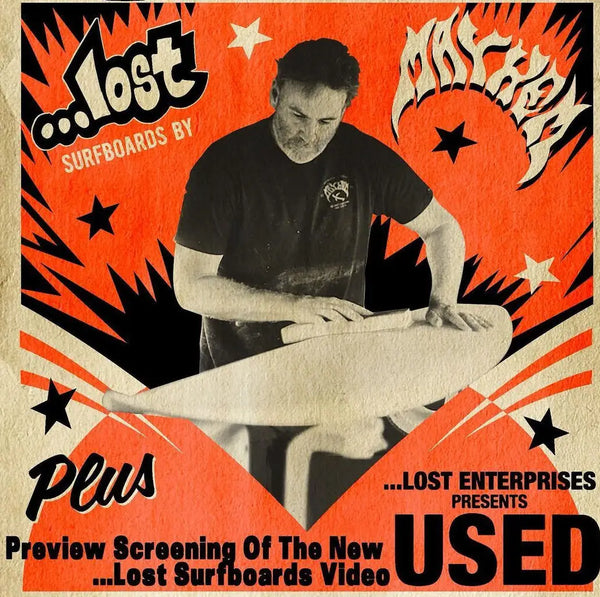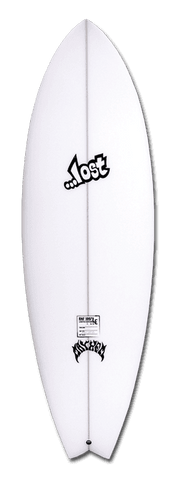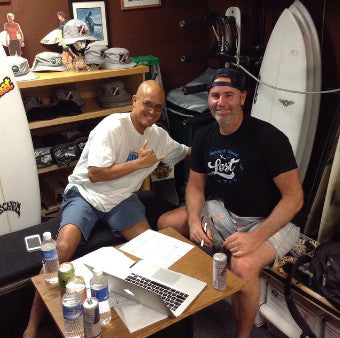LOST Surfboards: The Legacy of Innovation
Share
SHOP NOW
Origins and Early Success
Lost Surfboards, co-founded by Matt "Mayhem" Biolos and a group of school friends in 1985, has left an indelible mark on the surfing world. The company's journey began with the iconic round nose fish (RNF), a board that redefined surfboard design and remains one of the top-selling boards globally. The RNF 96, with its glass-on side fins and small FCS tailer, was a game-changer, especially during the early days of FCS's removable fins. This innovative approach to board design set the stage for Lost Surfboards' future success.

The RNF Legacy and Collaborations
The RNF's influence extended to the creation of the "5'5" 19 1/4" video, which featured renowned surfers such as Cory and Shea Lopez, Andy and Bruce Irons, Chris Ward, and even Tom Curren riding Lost's shorter, wider boards. The video also famously showcased the discovery of Skeleton Bay in Namibia, a place that has since become a popular destination, thanks to the video's early exposure.
Additionally, Lost Surfboards has collaborated with various industry experts like Drew from Florida to create innovative board designs that have resonated with surfers worldwide.
Pushing Boundaries
Lost Surfboards' influence goes beyond the RNF, with other iconic boards like the Rock Up gaining widespread recognition. The 2009 video “5’5” x 19 1⁄4” Redux” showcased what exactly Lost's short, high-volume boards were capable of, including Cory Lopez’s pioneering ride at Skeleton Bay.
The company's commitment to pushing the envelope in surfboard design has led to collaborations with shapers like Lee Stacey, resulting in versatile surfboard models suitable for all conditions. Lost's impact even extends to snowboarding, where they have made significant contributions to board design.
The LOST Surfboards History

Lost and Mayhem were not always household names. A little over two decades ago, Matt Biolos’s surfboard label was just beginning to gain traction in Southern California, where his short, wide, thicker boards were helping the average surfer rediscover their stoke for speed. "Guys buy my boards, and it's two-foot Trestles, and suddenly they're out there having the time of their life,” Matt once said. “I don't know. I'm just a big fat dude and I make boards that work for me. Which means they work for a lot of other people too."
Matt played a huge role in bringing these user-friendly high performance boards into the mainstream, and was named Surfing Magazine’s Shaper of the Year in 2010.

But perhaps the greatest evidence of his genius and contribution comes in the form of the …Lost library of surf flicks. Sometime around the mid-1990s, …Lost’s surf videos began to dominate the VCRs of the various coastal towns. Full of vulgarity, Jackass-style stunts, and drunken debauchery, the videos were a hit with the new generation of disillusioned, punky young rippers. But as much as the filler content entertained us, it was the surfing that truly drew us in.
Matt Biolos and the crew at …Lost figured out 10 years before everyone else that short and wide equals more speed, and more speed equals more fun. Test subjects like Cory and Shea Lopez, Andy and Bruce Irons, Chris Ward, and even Tom Curren were riding fish-inspired surfboards nearly half a foot shorter than everyone else, and having a blast doing so. The fuller outlines and noses of these boards led to more projection down the line, even in fatter waves, and their decreased length made them maneuverable both on the face and in the air.
By 2009, nearly everyone had a stubby shred stick in their quiver, so Redux was going to have to deliver something special if it were to maintain the signature cutting-edge offerings of …Lost, let alone outshine the original 5'5" x 19 ¼". Not only did the early films feature surfing that was completely different than what anyone else was doing at the time, but they had that funny homeless guy riding shopping carts down stairs and lighting himself on fire.
The Journey
The journey of Lost Surfboards has been a mix of highs and lows, marked by raw, unfiltered videos showcasing the reality of the surf world. This authentic approach, coupled with groundbreaking board designs, reflects the innovation and passion of Lost's founders. Their influence on surf culture is undeniable.
Today, Lost Surfboards continues to be known for quality and performance, favored by both amateur and professional surfers. With over half of amateur surfers at one point riding their boards, Lost's legacy is firmly cemented as icons in the surf industry. Their story exemplifies how commitment to quality, performance and pushing boundaries can make a surfboard brand into a household name.
Answering Common Questions
- Who Owns Lost Surfboards? Lost Surfboards is co-owned by Matt "Mayhem" Biolos and Mike Reola.
- Are Lost Surfboards Good? Yes, Lost Surfboards are highly regarded for their quality and performance. They are favored by numerous amateur and professional surfers, with over half of the amateurs at one time riding Lost Surfboards.
- Are Lost Surfboards Hand Shaped? Lost Surfboards are a combination of innovation, employment of cutting edge technology, a seamless supply chain, and a focus on customer needs for the brand to get to where it is today.
- Where Are Lost Surfboards Made? Lost Surfboards is based in Irvine, California.
- When Was Lost Surfboards Founded? Lost Surfboards was founded in 1985.
- Who Is Mayhem of Lost Surfboards? Mayhem is the nickname of Matt Biolos, the co-founder and shaper of Lost Surfboards.
Explore Our Collection of Lost Surfboards Now!
RELATED ARTICLES🔎
LOST SURFBOARDS’ RNF RETRO REVAMP DOUBLE DART
LOST SURFBOARD MODEL RNF 96 IN BLACK SHEEP CONSTRUCTION
BLACK SHEEP CARBON FIBER CONSTRUCTION FROM …LOST
DOUBLEDART FROM …LOST: THE FUTURE OF CARBON FIBER SURFBOARDS

